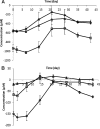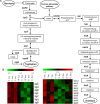Molecular and metabolic adaptations of Lactococcus lactis at near-zero growth rates
- PMID: 25344239
- PMCID: PMC4272703
- DOI: 10.1128/AEM.02484-14
Molecular and metabolic adaptations of Lactococcus lactis at near-zero growth rates
Abstract
This paper describes the molecular and metabolic adaptations of Lactococcus lactis during the transition from a growing to a near-zero growth state by using carbon-limited retentostat cultivation. Transcriptomic analyses revealed that metabolic patterns shifted between lactic- and mixed-acid fermentations during retentostat cultivation, which appeared to be controlled at the level of transcription of the corresponding pyruvate dissipation-encoding genes. During retentostat cultivation, cells continued to consume several amino acids but also produced specific amino acids, which may derive from the conversion of glycolytic intermediates. We identify a novel motif containing CTGTCAG in the upstream regions of several genes related to amino acid conversion, which we propose to be the target site for CodY in L. lactis KF147. Finally, under extremely low carbon availability, carbon catabolite repression was progressively relieved and alternative catabolic functions were found to be highly expressed, which was confirmed by enhanced initial acidification rates on various sugars in cells obtained from near-zero-growth cultures. The present integrated transcriptome and metabolite (amino acids and previously reported fermentation end products) study provides molecular understanding of the adaptation of L. lactis to conditions supporting low growth rates and expands our earlier analysis of the quantitative physiology of this bacterium at near-zero growth rates toward gene regulation patterns involved in zero-growth adaptation.
Copyright © 2015, American Society for Microbiology. All Rights Reserved.
Figures








Similar articles
-
Genome-wide transcriptional responses to carbon starvation in nongrowing Lactococcus lactis.Appl Environ Microbiol. 2015 Apr;81(7):2554-61. doi: 10.1128/AEM.03748-14. Epub 2015 Jan 30. Appl Environ Microbiol. 2015. PMID: 25636846 Free PMC article.
-
Dynamics in Copy Numbers of Five Plasmids of a Dairy Lactococcus lactis Strain under Dairy-Related Conditions Including Near-Zero Growth Rates.Appl Environ Microbiol. 2018 May 17;84(11):e00314-18. doi: 10.1128/AEM.00314-18. Print 2018 Jun 1. Appl Environ Microbiol. 2018. PMID: 29572209 Free PMC article.
-
Quantitative physiology of Lactococcus lactis at extreme low-growth rates.Environ Microbiol. 2013 Aug;15(8):2319-32. doi: 10.1111/1462-2920.12104. Epub 2013 Mar 5. Environ Microbiol. 2013. PMID: 23461598
-
Physiological and Transcriptional Responses of Different Industrial Microbes at Near-Zero Specific Growth Rates.Appl Environ Microbiol. 2015 Sep 1;81(17):5662-70. doi: 10.1128/AEM.00944-15. Epub 2015 Jun 5. Appl Environ Microbiol. 2015. PMID: 26048933 Free PMC article. Review.
-
Lifestyle, metabolism and environmental adaptation in Lactococcus lactis.FEMS Microbiol Rev. 2020 Nov 24;44(6):804-820. doi: 10.1093/femsre/fuaa033. FEMS Microbiol Rev. 2020. PMID: 32990728 Review.
Cited by
-
Stress Physiology of Lactic Acid Bacteria.Microbiol Mol Biol Rev. 2016 Jul 27;80(3):837-90. doi: 10.1128/MMBR.00076-15. Print 2016 Sep. Microbiol Mol Biol Rev. 2016. PMID: 27466284 Free PMC article. Review.
-
A Novel Method for Long-Term Analysis of Lactic Acid and Ammonium Production in Non-growing Lactococcus lactis Reveals Pre-culture and Strain Dependence.Front Bioeng Biotechnol. 2020 Oct 8;8:580090. doi: 10.3389/fbioe.2020.580090. eCollection 2020. Front Bioeng Biotechnol. 2020. PMID: 33163481 Free PMC article.
-
A Reproducible and Scalable Process for Manufacturing a Pfs48/45 Based Plasmodium falciparum Transmission-Blocking Vaccine.Front Immunol. 2021 Jan 11;11:606266. doi: 10.3389/fimmu.2020.606266. eCollection 2020. Front Immunol. 2021. PMID: 33505395 Free PMC article.
-
Systems-Level Analysis of the Global Regulatory Mechanism of CodY in Lactococcus lactis Metabolism and Nisin Immunity Modulation.Appl Environ Microbiol. 2022 Mar 8;88(5):e0184721. doi: 10.1128/AEM.01847-21. Epub 2022 Jan 19. Appl Environ Microbiol. 2022. PMID: 35044848 Free PMC article.
-
Contribution of YthA, a PspC Family Transcriptional Regulator of Lactococcus lactis F44 Acid Tolerance and Nisin Yield: a Transcriptomic Approach.Appl Environ Microbiol. 2018 Mar 1;84(6):e02483-17. doi: 10.1128/AEM.02483-17. Print 2018 Mar 15. Appl Environ Microbiol. 2018. PMID: 29305506 Free PMC article.
References
-
- Hugas M, Monfort JM. 1997. Bacterial starter cultures for meat fermentation. Food Chem 59:547–554. doi:10.1016/S0308-8146(97)00005-8. - DOI
MeSH terms
Substances
Associated data
- Actions
- Actions
LinkOut - more resources
Full Text Sources
Other Literature Sources
Molecular Biology Databases

